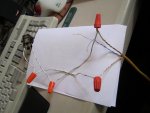I performed an experiment:
I performed an experiment:
Sorry if I'm late to the table, here (I must log in more often), but my two centavos are that this is a poor design just asking for trouble. Doorbells typically draw close to 1 amp when actuated, so that pulse will probably be induced into the phone line. This would be a problem whether the bell circuit is carried over 'bell wire' or Cat 6 (much less induction using a single pair of Cat 6, though). However, if you use Cat 6, voltage drop might be an issue, as well (23 gauge having much higher R than 18 or 20). If you common the 4 pairs together as suggested, then you lose much of the humbucking provided and give yourself a rather messy splice at each end. (This could also be considered a violation of 'neat and workmanlike' NEC 800.24; it's certainly a violation of common sense! Is Cat 6 that much cheaper than bell wire?) Another problem could crop up down the line, when they change doorbells to a noisier, higher-current type.
Let me ask a dumbass question: Why are these cables being run in conduit? I'd suggest ditching the conduit, if possible and running them with at least 2 inches separation OR running just the bell wiring outside the conduit (but not supported by it as that would be a violation).
"close to 1 amp" -- typically doorbells are rung for 30 seconds or less. Not enough time for the wire to even warm. Typically off for 15 minutes to 1 day.
#24 5.25 ohms/100ft 3 paralleled 1.75/100ft 4 paralleled 1.3/100ft
Messy -- picture to follow on another post
Experiment:
148 feet of cat5/cmp cable. 4 pair 24awg solid. (scrap laying around)
At each end connect orange, green, and brown; and or/white, gr/white, and br/white.
near end 24VAC class 2 transformer (just something laying around)
near end Triplett "The Fox" toner use for talk battery
far end 1A2 intercom buzzer, Harris ts19 BUTT SET
connect fox to bl-bl/w
connect buttset to bl-bl/w
connect transformer to o gr br and later o/w gr/w br/w
connect buzzer to o gr br and o/w gr/w br/w
Turn fox to talk
turn buttset to talk
>>> silence. clicking when connect/disconnect talk battery
connect transformer to o/w gr/w br/w
>>> buzzer sounding
>>> no sound on buttset
disconnect transformer
>>> click when disconnecting transformer.
"why cat 6" only have to carry a single CMP cable on the truck, use it for ethernet, telephone, door bells, door lock circuits ....
"why conduit" If you want to replace the signal conductors, putting them in a conduit will preclude having to dig up the lawn again.
Conduit is underground so supporting is not an issue.


